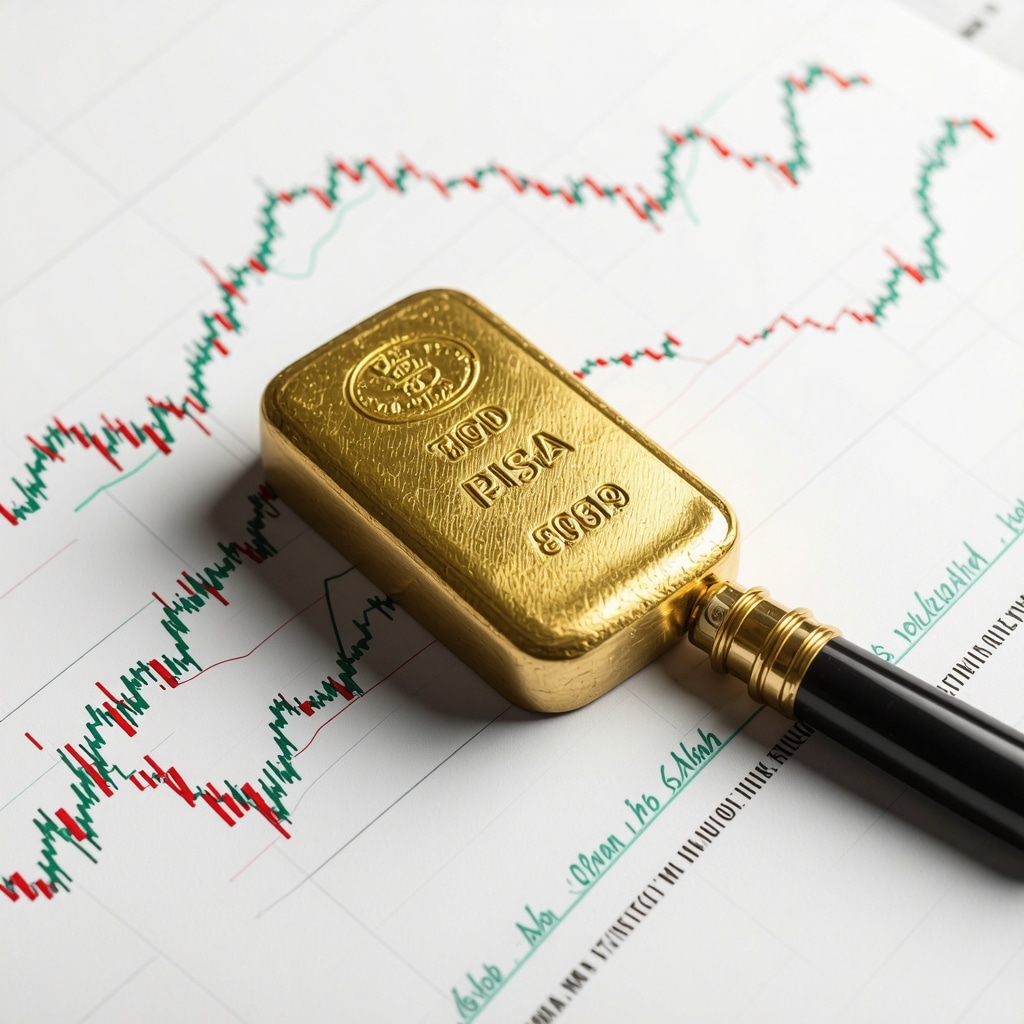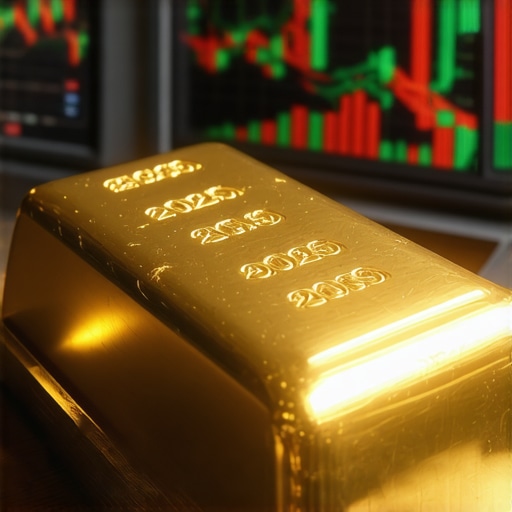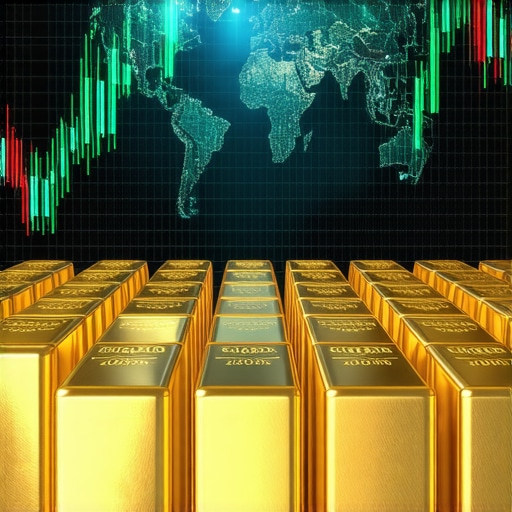Understanding the Complex Dynamics Behind Gold Price Movements in 2025
Gold continues to captivate investors and analysts alike due to its unique role as a safe-haven asset and a hedge against economic uncertainties. In 2025, the intricate interplay of macroeconomic variables, geopolitical events, and market psychology shapes the trajectory of gold prices more than ever. This analysis delves into the nuanced factors influencing gold’s valuation, moving beyond simplistic supply-and-demand narratives to reveal the layered forces at play.
Macroeconomic Drivers and Their Impact on Gold Valuation
The persistent inflationary pressures combined with fluctuating real interest rates significantly influence gold’s appeal. As central banks navigate complex monetary policies to balance growth and inflation, gold’s inverse relationship with real yields becomes a critical determinant. The Federal Reserve’s stance on interest rates, for instance, has direct ramifications on gold’s opportunity cost, affecting investor allocations.
Moreover, currency fluctuations, especially the US dollar’s strength, add another dimension. A weakening dollar typically elevates gold prices, making it more attractive for holders of other currencies. This dynamic is compounded by emerging market demand shifts, where increased gold accumulation by central banks in Asia and the Middle East acts as a stabilizing force against market volatility.
How Do Central Bank Gold Purchases Influence Market Sentiment and Price Momentum?
Central bank gold buying remains a pivotal factor that often escapes retail investor scrutiny. These purchases not only affect physical demand but also signal confidence or caution in broader economic outlooks. For example, increased acquisitions by countries seeking to diversify reserves can ignite positive price momentum, reinforcing gold’s role as a strategic asset. Understanding the timing and scale of these interventions is essential for anticipating price movements.
Advanced Analytical Perspectives: Supply Constraints and Technological Demand
While traditional analyses focus on jewelry and investment demand, the technological applications of gold in electronics and medical devices introduce a subtle but growing influence on supply-demand equilibrium. Mining output constraints, exacerbated by geopolitical tensions in resource-rich regions, add supply-side risks that can amplify price volatility.
In parallel, recycling trends and environmental regulations are reshaping gold availability, creating an evolving supply landscape that sophisticated investors must monitor closely.
Integrating Gold ETFs and Futures for Sophisticated Portfolio Strategies
For investors seeking to capitalize on 2025’s gold market dynamics, combining physical gold holdings with financial instruments like ETFs and futures offers enhanced flexibility and risk management. Gold ETFs provide liquidity and ease of access, while futures contracts enable strategic positioning in anticipation of price swings. Understanding the differential impacts of these vehicles on portfolio performance is crucial, as outlined in this expert comparison of gold ETFs and futures.
Such integration requires a deep understanding of market timing, margin requirements, and regulatory frameworks to optimize outcomes.
Expert-Level Insights and Further Exploration
Investors aiming to enhance their mastery of gold investment strategies should consider exploring advanced analyses on key economic drivers shaping gold prices in 2025 and comprehensive demand trend evaluations. Engaging with professional communities and contributing empirical observations can further refine strategic approaches.
For academically rigorous perspectives, see the World Gold Council’s detailed market reports, which provide authoritative data and forecasts (World Gold Council Research).
Ready to deepen your portfolio’s potential? Explore our advanced guides on gold ETFs and futures trading techniques to position yourself for profitable outcomes in 2025.
Decoding the Role of Geopolitical Shifts in Gold Price Volatility
Geopolitical events in 2025 continue to exert profound influence on gold prices, often triggering rapid market reactions that challenge even seasoned investors. Situations such as regional conflicts, trade tensions, and sanctions can disrupt supply chains and create uncertainties that elevate gold’s status as a safe haven. For example, disruptions in mining operations within politically unstable regions can tighten supply unexpectedly, while investor flight to gold can intensify demand-driven price spikes.
Understanding the geopolitical landscape requires monitoring global developments closely and assessing their potential to affect both physical and paper gold markets. This vigilance enables investors to anticipate volatility and position their portfolios accordingly.
What Are the Emerging Technological Innovations Impacting Gold Investment Strategies?
The integration of technology within gold investment is evolving rapidly, particularly through blockchain-based platforms and digital gold tokens that promise increased transparency and liquidity. These innovations are reshaping traditional barriers to gold ownership by facilitating fractional ownership and simplifying transaction processes.
Moreover, advances in data analytics and artificial intelligence enable more sophisticated market analysis, enhancing the ability to predict price movements based on complex patterns. Investors leveraging these tools can gain a strategic edge by identifying subtle market signals that precede shifts in gold’s valuation.
However, these technological developments also introduce new risks, including cybersecurity threats and regulatory uncertainties, which must be factored into decision-making frameworks.
Strategic Diversification: Balancing Physical Gold with Digital and Derivative Instruments
In 2025, a nuanced portfolio strategy incorporates a mix of physical gold, gold ETFs, futures, and emerging digital gold assets. Physical gold offers intrinsic value and a hedge against systemic risk, while ETFs and futures provide liquidity and tactical exposure to price fluctuations. Digital gold tokens add accessibility and fractional investment opportunities, appealing to a broader spectrum of investors.
Balancing these components requires an understanding of each instrument’s unique risk profile, cost structure, and market dynamics. For instance, while futures amplify leverage opportunities, they also carry margin call risks that can rapidly impact portfolio stability. Similarly, digital gold assets, although innovative, may lack the regulatory protections afforded to traditional instruments.
Investors should consider their risk tolerance, investment horizon, and liquidity needs when constructing a diversified gold portfolio. Resources like how to build a balanced portfolio with gold ETFs and stocks offer valuable frameworks for achieving optimal asset allocation.
Environmental and Ethical Considerations in Gold Investing: Emerging Trends
Increasingly, investors are integrating environmental, social, and governance (ESG) criteria into their gold investment decisions. The mining sector’s environmental footprint, labor practices, and community impact are under greater scrutiny, influencing demand for responsibly sourced gold.
Certified “green” gold products and funds that emphasize ethical sourcing are gaining traction, reflecting a shift toward sustainable investment portfolios. This trend affects market pricing by potentially increasing premiums on compliant gold and creating differentiation within gold ETFs and mutual funds.
Staying informed about ESG developments is crucial for investors aiming to align financial returns with ethical considerations, as well as to anticipate how evolving regulations may impact gold supply and costs.
Leveraging Expert Data and Market Intelligence for Informed Decisions
Data-driven decision-making is paramount in navigating 2025’s complex gold market. Trusted sources like the World Gold Council Research provide invaluable insights into supply-demand metrics, investment trends, and price forecasts, underpinning sophisticated investment strategies.
Complementing this, advanced analytics platforms offer real-time data and predictive modeling, enabling investors to fine-tune entry and exit points. Integrating these tools with fundamental analysis enhances the capacity to respond dynamically to market shifts.
Invitation to Engage: Share Your Insights and Strategies
We encourage readers and fellow experts to comment below with your perspectives on advanced gold investment strategies in 2025. Sharing experiences on integrating technological innovations, geopolitical analysis, or ESG considerations enriches the community’s collective expertise. Consider also exploring our detailed guides on gold ETFs versus futures for portfolio optimization and key economic drivers affecting gold prices in 2025 to deepen your strategic approach.
Harnessing ESG Metrics: The New Frontier in Gold Investment Decision-Making
In 2025, Environmental, Social, and Governance (ESG) considerations have transcended from a niche concern to a central pillar of sophisticated gold investment strategies. The mining sector’s environmental footprint—ranging from carbon emissions to water usage—alongside labor standards and community relations, increasingly informs investor sentiment and asset valuation. This evolution is driven not only by ethical imperatives but also by regulatory frameworks tightening globally, which directly impact operational costs and supply stability.
Investors now prioritize gold sourced through responsible mining practices, often certified by third-party organizations such as the Responsible Jewellery Council (RJC) and initiatives like the London Bullion Market Association’s (LBMA) Responsible Gold Guidance. These certifications act as quality signals that can justify price premiums and bolster long-term demand resilience. Moreover, ESG integration challenges traditional portfolio construction by necessitating granular due diligence and the inclusion of sustainability metrics alongside financial KPIs.
How Do ESG Considerations Affect Gold Supply Chains and Investment Risk Profiles?
ESG concerns present multifaceted risks and opportunities across the gold supply chain. Environmental regulations can restrict mining activities or impose costly remediation requirements, potentially tightening physical supply. Social conflicts or labor disputes can disrupt operations, elevating geopolitical risk premiums. Conversely, companies proactively embracing ESG standards may benefit from enhanced brand reputation, access to green financing, and improved stakeholder relations.
From an investment perspective, integrating ESG metrics facilitates more nuanced risk assessments, enabling portfolio managers to identify latent vulnerabilities and future-proof allocations. This approach aligns with emerging fiduciary duties and appeals to a growing cohort of socially conscious investors, thereby expanding the capital base for compliant gold assets.
Leveraging Cutting-Edge Data Analytics and AI to Decode Gold Market Complexities
The advent of advanced data science techniques and artificial intelligence (AI) is revolutionizing gold market analysis. Traditional models, reliant on linear correlations and historical trends, are increasingly supplemented or supplanted by machine learning algorithms capable of parsing vast datasets encompassing macroeconomic indicators, geopolitical events, social media sentiment, and even satellite imagery of mining operations.
These AI-driven tools unearth subtle patterns and nonlinear relationships that escape conventional analysis, offering predictive insights into price volatility, trade flows, and investor behavior. For instance, natural language processing (NLP) algorithms analyze real-time news feeds to gauge market sentiment shifts, while predictive models simulate supply disruptions based on geopolitical risk indices.
Yet, the integration of AI requires vigilance against overfitting, data biases, and the opacity of some algorithmic decisions. Investors adept at combining human expertise with these technological advances can achieve a strategic edge in navigating 2025’s volatile gold landscape.
Strategic Innovations in Portfolio Construction: Integrating Physical, Derivative, and Digital Gold Assets
Modern portfolio theory is being redefined by the inclusion of diversified gold instruments that balance liquidity, leverage, and accessibility. Physical gold remains the cornerstone for risk-averse investors seeking tangible asset security. However, the complementary use of ETFs and futures contracts empowers sophisticated tactics such as hedging, arbitrage, and tactical asset allocation.
Digital gold platforms—leveraging blockchain technology—are democratizing access to gold ownership through fractionalized, instantly transferable tokens. These platforms offer novel liquidity profiles and transparency advantages but also introduce unique counterparty and cybersecurity risks.
Balancing these asset types necessitates rigorous evaluation of regulatory environments, custody solutions, and cost structures. For example, futures contracts entail margin requirements and potential mark-to-market volatility that can amplify gains or losses, while digital gold tokens require confidence in the underlying asset custody and platform integrity.
For an in-depth exploration of these innovative portfolio strategies, consult expert analyses such as gold ETFs versus futures for portfolio optimization and how to build a balanced portfolio with gold ETFs and stocks.
Quantifying Supply Chain Vulnerabilities: Geopolitical Risks and Technological Disruptions
Supply chain fragility remains a critical vector influencing gold price volatility. Mining operations localized in politically unstable regions are susceptible to sudden disruptions due to conflict, regulatory shifts, or labor unrest. Additionally, technological bottlenecks—such as shortages in key mining equipment or environmental compliance technologies—can hinder output expansion or maintenance.
Integrating real-time geopolitical risk indices with mining production data enhances the predictive accuracy of supply-side shocks. Investors employing this approach can anticipate inventory tightness and potential price spikes, positioning their allocations correspondingly.
Moreover, advancements in remote sensing and satellite imagery provide unprecedented visibility into mining activities, enabling proactive monitoring of production trends and potential disruptions.

What Are the Latest Tools for Real-Time Monitoring of Gold Supply and Demand Dynamics?
Innovative platforms now blend satellite data, trade statistics, and AI analytics to offer near-real-time insights into gold supply chains and market flows. These tools incorporate machine learning models trained on historical disruption patterns, geopolitical event databases, and social media analytics to forecast demand surges or supply constraints.
For example, the World Gold Council’s Gold Hub Research complements these emerging technologies by providing authoritative data and in-depth market reports that support evidence-based investment decisions.
Adopting such tools empowers investors to move beyond reactive strategies, embracing proactive, data-driven approaches that anticipate market inflections and mitigate downside risks.
Engage further with cutting-edge gold investment methodologies by exploring our detailed resources and joining expert forums dedicated to advancing knowledge in this evolving field.
Deciphering AI-Driven Market Sentiment Analysis in Gold Trading
The integration of artificial intelligence into gold investment strategies is no longer a futuristic concept but a present reality that delivers unprecedented analytical depth. Advanced natural language processing models parse global news, social media chatter, and economic reports to generate sentiment indices that anticipate shifts in investor behavior before traditional indicators reflect them. This proactive insight enables portfolio managers to adjust their gold exposure tactically, mitigating downside risk and capitalizing on emerging bullish trends.
Furthermore, machine learning algorithms continuously recalibrate predictive models by assimilating new data, enhancing forecasting accuracy for gold price volatility driven by geopolitical tensions or macroeconomic surprises. Such dynamic adaptation is crucial, given the complex, nonlinear relationships characterizing the gold market in 2025.
How Can Investors Integrate ESG Metrics with AI Analytics to Optimize Gold Portfolio Risk-Adjusted Returns?
Combining ESG data with AI-powered analytics offers a sophisticated framework for identifying gold assets that align with sustainability mandates while optimizing financial performance. Investors can deploy AI tools to screen mining companies based on environmental impact scores, social responsibility indices, and governance ratings, effectively weighting portfolios toward entities demonstrating operational resilience and regulatory compliance.
This fusion of ESG considerations and technological analytics also facilitates scenario simulations that quantify potential supply disruptions due to environmental regulations or labor disputes, allowing for preemptive portfolio adjustments. Institutional investors, in particular, benefit from this dual approach as fiduciary standards evolve to incorporate sustainability alongside profitability.
Leveraging Blockchain-Enabled Digital Gold for Enhanced Transparency and Fractional Ownership
Blockchain technology continues to revolutionize gold investment by enabling digital tokens backed by physical gold reserves. These tokens provide fractional ownership opportunities, lower entry barriers, and instant settlement capabilities, fostering greater market inclusivity and liquidity. The immutable nature of blockchain records also enhances transparency, addressing concerns over provenance and ethical sourcing.
However, investors must carefully evaluate platform custodianship, regulatory compliance, and cybersecurity protocols to mitigate risks unique to digital gold instruments. Strategic incorporation of blockchain-based assets alongside traditional holdings can yield diversified exposure and improved portfolio agility.
Institutional-Grade Predictive Analytics: Navigating Supply Chain Fragilities with Satellite and Geopolitical Data Fusion
Emerging analytical frameworks synergize satellite imagery, geopolitical risk indices, and AI-driven trade flow analysis to monitor gold mining operations and anticipate supply chain disruptions with remarkable precision. For example, real-time satellite data can detect anomalies in mine activity, enabling swift responses to potential output constraints stemming from political unrest or environmental incidents.
By fusing these disparate data streams, investors gain a holistic view of supply vulnerabilities that traditional reporting mechanisms may miss. This comprehensive situational awareness is critical for timing market entries and exits during periods of heightened volatility.

Exploring Regulatory Developments Shaping Digital and Derivative Gold Instruments in 2025
The regulatory landscape governing gold derivatives and digital assets is rapidly evolving, presenting both challenges and opportunities for investors. Heightened scrutiny from financial authorities aims to ensure market integrity, protect investors, and prevent illicit activities, while also fostering innovation in compliant frameworks.
Understanding jurisdiction-specific regulations, margin requirements, and custodial standards is essential for sophisticated investors to navigate these changes effectively. Staying abreast of regulatory updates through authoritative sources like the International Monetary Fund’s Working Papers on Digital Asset Regulation empowers informed decision-making in this fluid environment.
Engage with our latest analyses and expert forums to harness the synergy of AI, ESG, and blockchain in crafting resilient gold investment portfolios for 2025 and beyond.
Expert Insights & Advanced Considerations
Integrating AI-Driven Analytics with ESG Metrics Elevates Gold Portfolio Resilience
Harnessing artificial intelligence to analyze environmental, social, and governance factors enables investors to identify gold assets with superior sustainability profiles and enhanced risk-adjusted returns. This synergy empowers portfolio managers to anticipate regulatory impacts and supply chain disruptions, creating a forward-looking investment framework that transcends traditional financial metrics.
Real-Time Satellite and Geopolitical Data Fusion Offers Unmatched Supply Chain Visibility
Leveraging satellite imagery combined with geopolitical risk indices provides investors with unparalleled insight into mining operations and regional stability. This proactive monitoring allows for timely adjustments in gold allocations, mitigating exposure to sudden supply constraints and capitalizing on emerging market opportunities.
Balanced Allocation Among Physical, Derivative, and Digital Gold Instruments Optimizes Flexibility
A sophisticated gold investment strategy in 2025 involves tactically blending physical holdings with ETFs, futures, and blockchain-based digital gold tokens. Each instrument offers distinct advantages and risks; thoughtful integration maximizes liquidity, leverage, and security while aligning with evolving market and regulatory landscapes.
Central Bank Gold Purchases Remain a Critical Barometer for Market Sentiment
Understanding the patterns and scale of central bank acquisitions is essential for anticipating gold price momentum. These strategic purchases not only influence physical demand but also signal broader economic confidence or caution, directly affecting investor positioning and price trajectories.
Incorporating Technological Innovations Requires Vigilant Risk Management
The rise of blockchain-enabled gold tokens and AI-based market analysis introduces novel opportunities alongside cybersecurity and regulatory challenges. Investors must maintain rigorous due diligence to balance innovation benefits with emerging risks, ensuring portfolio integrity and compliance.
Curated Expert Resources
World Gold Council Research – Offers comprehensive market reports, authoritative data on supply-demand dynamics, and insightful forecasts essential for evidence-based gold investment strategies (Gold Hub Research).
International Monetary Fund Working Papers on Digital Asset Regulation – Provides critical analysis and updates on the evolving regulatory frameworks governing digital gold and derivatives, empowering investors to navigate compliance risks effectively (IMF Digital Asset Regulation).
Buying Gold Now’s Expert Guides – A curated collection of advanced insights on topics such as gold ETFs versus futures, 2025 gold price forecasts, and central bank purchase impacts to deepen strategic understanding.
Satellite Data and AI Analytics Platforms – Emerging tools integrating real-time imagery and machine learning models that revolutionize supply chain risk assessment and market sentiment analysis.
Final Expert Perspective
In the evolving landscape of gold investment in 2025, mastery lies in synthesizing diverse analytical approaches—from ESG integration and AI-driven market intelligence to balancing physical and innovative digital assets. Central bank behaviors and geopolitical developments continue to cast long shadows over price movements, underscoring the necessity for dynamic, data-informed strategies. Investors equipped with these advanced insights and supported by authoritative resources are best positioned to navigate complexities and capitalize on opportunities within the gold market.
For those committed to refining their expertise and optimizing gold investment outcomes, we invite you to engage with our detailed analyses and join the conversation on innovative portfolio strategies at building balanced gold portfolios. Your professional insights and experiences enrich the collective understanding of this multifaceted market.











This in-depth analysis of the 2025 gold market truly highlights how multifaceted the investment landscape has become. I’ve recently been exploring blockchain-based gold tokens, and it’s fascinating to see how these digital assets are fostering greater liquidity and transparency in gold ownership. However, the regulatory uncertainties surrounding these platforms still pose questions for me. Have any seasoned investors here experienced hurdles when integrating traditional gold holdings with digital tokens, especially regarding custody and compliance? Personally, I believe that as ESG considerations grow tighter, sourcing responsibly mined gold will become not just a moral choice but a strategic one for long-term stability. It’s intriguing to think about how central bank buying patterns and geopolitical tensions will continue to influence prices—do you all see these factors playing a more prominent role than macroeconomic data in the near future? I look forward to hearing different strategies on balancing physical assets with innovative financial instruments in a volatile environment.